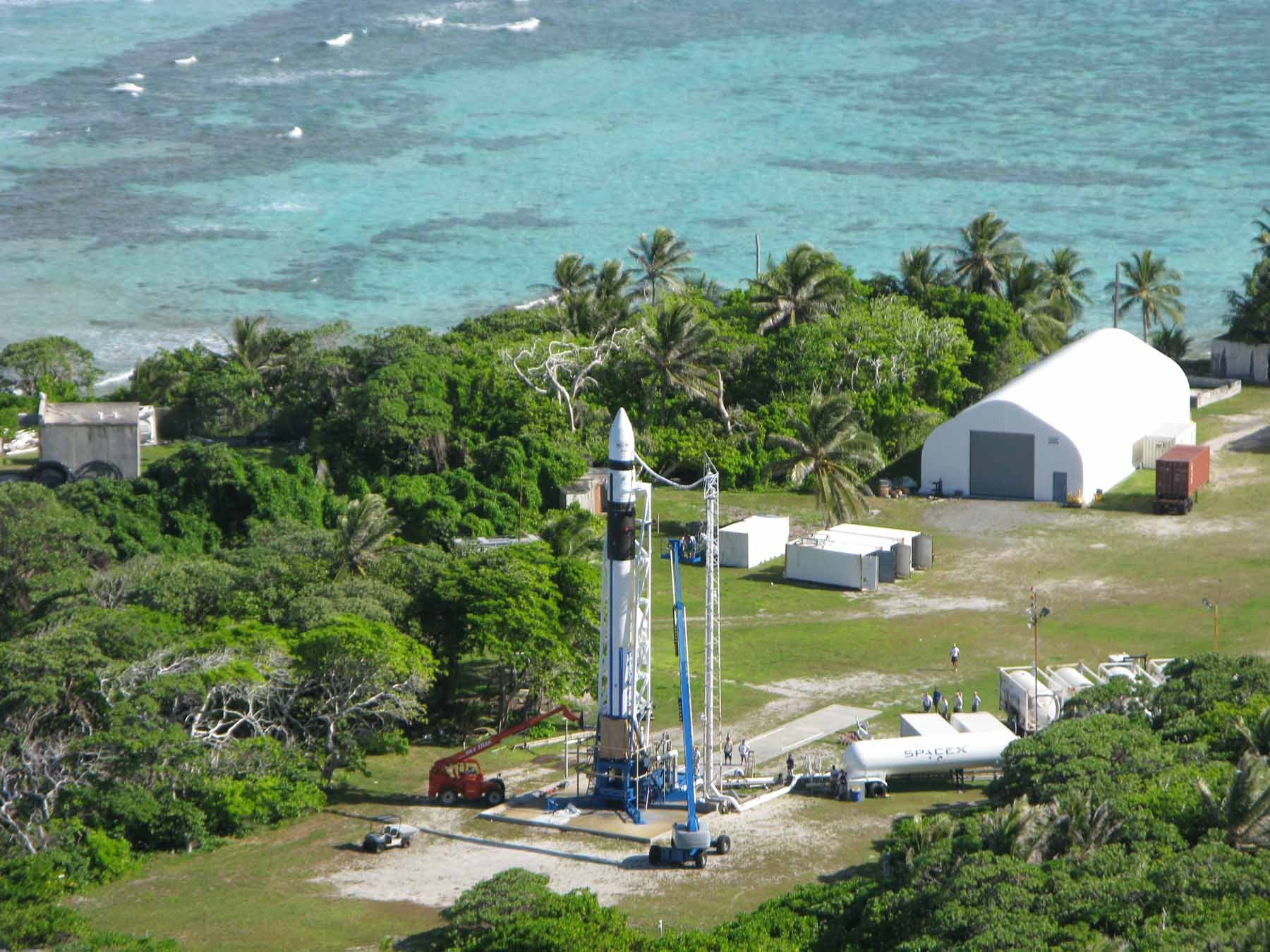[/caption]
It was announced that the private space company, SpaceX, had set today as their launch window for their Falcon 1 rocket system to orbit the Earth. The press release reads:
Space Exploration Technologies Corp. (SpaceX) has scheduled the launch of the Falcon 1 Flight 3 mission for Saturday, August 2nd. The launch window will open at 4:00 p.m. (PDT) / 7:00 p.m. (EDT) and remain open for five hours. If launch is delayed for any reason, SpaceX has range availability to resume countdown through August 5.
Lift-off of the vehicle will occur from SpaceX’s Falcon 1 launch site at the Kwajalein Atoll, about 2500 miles southwest of Hawaii. Falcon 1 launch facilities are situated on Omelek Island, part of the Reagan Test Site (RTS) at United States Army Kwajalein Atoll (USAKA) in the Central Pacific.
Update: Approximately 140 seconds into the flight, Falcon 1 suffered an undisclosed anomaly. The vehicle had just switched to inertial guidance mode. At the last check, it was travelling at a velocity of 1050 m/s at an altitude of 35 km. It is assumed Falcon 1 is lost. Webcast has now been closed.
The Falcon 1 rocket system
The California-based space systems company was founded by Elon Musk in 2002 to provide a commercial alternative to launching payloads into space. SpaceX is currently carrying out a series of test flights of their Falcon 1 rocket, which is a two-stage, liquid oxygen and kerosene fuelled launch vehicle. Falcon 1 has already undergone two test flights, one in March 2006 and the second was in March 2007. The first launch failed only 29 seconds into the flight after the main engine failed, causing the loss of the rocket. The 2007 launch had more success and reached a velocity of 11,000 miles/hour, but unfortunately did not attain orbital velocity. It lost control at around 300 miles altitude and was lost. Today marks the third test flight, and hopes are high that lessons have been learnt and Falcon 1 will be successfully inserted into a stable low Earth orbit.
The Falcon 1 first stage is powered by a single Merlin 1C Regenerative engine that SpaceX developed. This is the first time the Merlin 1C will be used. The second stage is powered by a single Kestrel engine (again, developed by the company).
If successful, this third test flight will be celebrated as the first new orbital rocket to be developed and launched for over ten years; it will also be the first new US hydrocarbon engine for an orbital booster to be flown in 40 years and only the second US engine of any kind in more than a quarter of a century. What makes this historic endeavour even more impressive, is that once Falcon 1 reaches orbit (hopefully within today’s launch window), SpaceX will be the world’s first private company to develop an operational liquid fuel rocket to orbit the Earth
UPDATE (8:43pm): The webcast presenters announced an “anomaly” during Falcon 1’s ascent. We await news about this event, but it is assumed Falcon 1 is lost.
More information from today’s press release: SpaceX


This is so sad. Keeping an eye open for announcements, but it ain’t looking good 🙁
Oh dear. Unfortunately the video my end was jumpy at best and missed the moment before signal switched to the HQ… still no details…
We going?
We staying?
Make up your minds!
….An anomaly?
Whats that mean in layman’s terms?
Ka-boom?
Anomaly = failure.
i guess it blew up
I’m impressed with the altitude and speed figures so far, but what kind of payload can that little thing deliver?
… I’m underwhelmed …
A solar sail test vehicle, a darpa sat, and a few other things were aboard.
The video showed a roll oscillation shortly before the signal was lost and the anomaly reported.
Since some of my Dad’s cremation remains were on board with 207 others, I’m extremely disappointed.
What I don’t like most is how the PR is being handled.
In one moment its a community event with open windows and inviting the public in to see what they do. Then something happens and the doors slam shut, roll credits, with no further information.
Thats bad business.
Choppy video prevented me from seeing the actual lift off though I waited patiently for two hours to see it. Perhaps the anomaly of the first attempt should have told them to play it safe but they went ahead anyway for the second try. I am impressed with the quickness of the built-in safety shut down system, but what good is if it isn’t heeded? The anomaly will now cost Space-X lost prestige and credibility. But they still have all the right stuff in my opinion seeing how far their dream has evolved so far. Just like in the early days of the Space Agency’s many bugs need to be worked out.
“They are lucky to have NASA for a prime COTS client.” Hmm . . . maybe that’s the problem with Falcon 1.
Pop goes the weasle.
SpaceX will prevail, ultimately. Launch from a Army range with a DOD payload, however micro, probably required some secrecy. May account for the surprise announcement. Wanting to prevent audiences from witnessing a failure doesn’t account for it. I can see the chatter now. They are lucky to have NASA for a prime COTS client, desiring greatly for their success.
Oh, what they couldn’t do with an old Atlas-Centaur right now.
The ‘anomoly’ dealt with separation of the stages. You will find a statement on their website here…
http://www.spacex.com/updates.php
I hope that the NanoScale D Project ( re. NASA?) is inexpensive enough that it can be tried again…maybe they can recover the one on this cargo.
I’m sorry that some (like Bryan) lost more than money or hopes on this shot, but all in all, it seems like another step forward, successful or not.